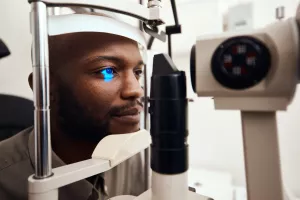Ocular melanoma is a type of cancer that starts in the cells that produce pigment (color) in the eye. If left untreated, these cancerous cells can grow and spread to other parts of the body.
Keeping a close eye on your vision health
Many of our most precious memories are rooted in what we see, like a breathtaking sunset, the game-winning score or the first time you saw the love of your life.
Having a condition, like ocular melanoma, that threatens your eyesight can be scary. The good news is that ocular melanoma is treatable if we can detect it early. When you place your vision care in our hands, our team of specialists will work together toward a common goal—giving you the best treatment possible that puts your comfort and quality of life first.

Conditions
When you hear melanoma, you may first think of the cancer that affects your skin. While ocular melanoma is different from skin-based melanoma, both forms develop in the cells that produce melanin. Your eyes, hair and skin all get their pigments from melanin.
Ocular melanoma comes in several forms with each one developing from the pigmented cells in your eye. These ocular melanomas each behave differently, and affect different parts of your eye:
- Conjunctival melanoma: This affects the thin, transparent layer that covers the white part of your eye.
- Iris melanoma: This affects the colored part of your eye.
- Choroidal melanoma: This affects the thin layer of blood vessels that sit behind the white part of your eye.
Testing
It’s important to schedule regular eye exams, especially if you have a family history of ocular melanoma or have other risk factors. The earlier we detect ocular melanoma, the better the treatment results.
Treatments
We’ll cover your condition from all angles and work alongside you to map a treatment path that’s uniquely you.
Plaque brachytherapy
This is the most common and effective method for treating ocular melanoma. Plaque brachytherapy is a surgical procedure where we implant a custom-made metal disc, or plaque, directly beneath the melanoma on the outside white of your eye.
Over the course of 5 days or so, your eye will gradually absorb small, safe amounts of radiation from the plaque that targets and eliminates the melanoma.
Gamma Knife
Originally developed to treat brain tumors, the ophthalmologists, radiation oncologists, and neurosurgeons on our team have been using Gamma Knife radiosurgery for certain ocular melanomas since the early 2000s.
This non-invasive procedure directs highly focused gamma rays to the melanoma area to destroy the cancerous cells. We’ll have you home and recovering from your Gamma Knife radiosurgery the same day.
Proton beam irradiation
This treatment is a surgical procedure that places metal clips on the white of the eye to locate the melanoma. Once we’ve pinpointed the cancerous cells, we’ll apply radiation to them around 5 times over a 10-day period.
Enucleation
Enucleation is the surgical removal of the eyeball. Opting for enucleation is a decision we don’t take lightly. It’s a choice we make when other treatments aren’t effective or when there’s no useful vision in the eye.

From regular office visits to inpatient stays, find the healthcare you need and deserve close to home.

Meet the doctors and care team devoted to supporting you every step of the way along your path to better health.